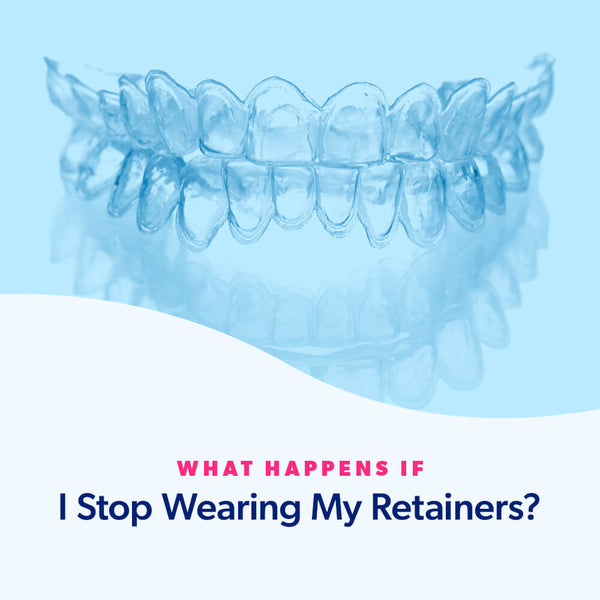
What Happens If I Stop Wearing My Retainers?
Everyone wants their teeth to be healthy and straight. An aligned smile can help you achieve greater confidence in personal and social settings. And when you put in the time, money and dedication to get your teeth straightened, you want them to stay that way for years to come. That's where retainers come in.
If you're reading this article, you may be wondering what happens if you stop wearing your retainer. Perhaps you have already stopped wearing yours and are looking for more information about your situation. Or, you could be considering stopping and want to know what could happen after making that decision. Wherever you are on your journey with retainers, you've come to the right place. Read on to find the answers you're looking for regarding wearing your retainer and what could happen if you quit.
Retainers 101: Basic Info You Should Know
To understand the importance of wearing your retainer, you should first learn more about this dental device. This section will help you know more about a retainer's function and the different types available.
What Does a Retainer Do?
A retainer is a dental device used to keep teeth straight after orthodontic treatment or to shift teeth into a straighter position. The most common use for a retainer is to do what its name implies — it retains your teeth's location to halt further movement.
As you age, it's typical for your teeth to shift. With proper care, retainers can help keep your teeth straight as the years go by. These dental appliances are especially crucial after receiving orthodontic treatment. We'll get into that more later in the article. For now, it's essential to know that a retainer is necessary to maintain your teeth's alignment after receiving teeth-straightening treatment.
What Are the Different Types of Retainers?
You learned about the two primary functions of retainers above. There are also two separate forms of retainers.
- Active retainers: Active retainers are the ones that can make slight adjustments to your teeth. These removable retainers apply pressure to your teeth to create small movements to help straighten them. You can also refer to active retainers as aligners.
- Passive retainers: Most retainers orthodontists provide are passive retainers, which hold your straightened teeth in place. They're the essential last step in many types of orthodontic treatment for straightening teeth.
In this article, we'll focus primarily on passive retainers, as forgetting to wear them can be detrimental to the longevity of your newly straightened teeth. Here are the types of passive retainers.
- Permanent retainers: Permanent retainers stay fixed in your mouth to keep your teeth straight for years to come. Your orthodontist will attach them to your straightened teeth with wiring or adhesive to keep them from shifting. Permanent retainers typically consist of a metal such as gold, making them resistant to corrosion or damage. Orthodontists often apply permanent retainers to a patient's bottom teeth and use a different type of retainer for the top. Keep in mind that permanent retainers can accumulate plaque and require some extra effort to keep clean.
- Removable plastic retainers: These retainers consist of a clear plastic material shaped to fit your teeth's exact specifications. Plastic retainers are discreet, fitting over your teeth in such a way that the people around you may not even know you're wearing them. You may recognize this type of retainer by a brand name such as Invisalign or other clear aligner and retainer companies. Removable plastic retainers are convenient to wear and are helpful for straightening your top and bottom sets of teeth.
- Removable Hawley retainers: Hawley retainers consist of colored acrylic and metal wiring that helps maintain your teeth's position after orthodontic treatment. You may be familiar with these retainers, as they were once the most common option after braces. Many orthodontists are shifting away from Hawley retainers in favor of clear plastic retainers, but Hawley retainers are still a trusty choice. Hawley retainers can last a long time, making them an excellent solution for retaining your teeth's positions for many years with proper care.
Who Should Wear a Retainer?
Anyone who has had their teeth straightened with braces, aligners or other methods should wear retainers to keep their teeth straight and ensure their results last for years to come. The retainer is the capstone that finishes the orthodontic process.
As you age, your teeth may start to crowd and shift as your jaw decreases in size. You may choose to wear a retainer later in life to help keep your teeth straighter despite the changes in your facial structure. If you're experiencing an increase in the gaps between your teeth, you may also choose to wear retainers to keep your teeth together. Shifting teeth usually signifies another dental issue you should address with your dentist to keep your teeth as healthy as possible.
Proper Retainer Wear
Now that you know more about retainers, the question remains — what constitutes correct retainer wear? If you have a retainer, you should do everything you can to follow your orthodontist's instructions to maintain your new, straight teeth position. There's a right way and a wrong way to use your retainer, and here's a spoiler alert — you must continue wearing it to keep your teeth aligned.
Read on to discover what could happen if you stop wearing your retainer and how long you should wear your retainer after having your teeth straightened.
What Happens If I Stop Wearing My Retainer?
Forgetting to wear your retainer can have severe consequences for your orthodontic progress. When you straighten your teeth, they need some persuasion to stay in their new positions. Your teeth have a "memory" of their former placement in your mouth, and they want to revert to this previous status quo after you finish your orthodontic treatment. Your retainer will provide the persuasion your teeth need to stay straight, replacing the memory of their old positions with their new, straighter ones.
Your teeth have ligaments that give them the flexibility to accommodate the rigors of chewing and changes to your facial structure as you age. When you finish getting your teeth straightened, these ligaments will try to pull your teeth back to their former placement. Wearing your retainer will help your teeth settle into their new locations and stay there even as your facial structure changes. If you stop wearing your retainer, your teeth could shift back to their old positions or into new, crooked ones.
Do I Have to Wear My Retainer Forever?
The short answer is "yes." If you take good care of your retainer — and keep track of it over the years — you should continue wearing it to help keep your teeth from moving. But you must consistently wear your retainer from the moment you finish your straightening process. Taking long breaks without your retainer and trying to use it again may cause unintended consequences.
Wearing your retainer forever does not mean you have to keep it in your mouth 24/7 for the rest of your life. You'll be glad to know that, as time goes by, the amount you have to wear your retainer to keep your teeth straight will decrease. In the next section, we'll discuss the appropriate length of time you should wear your retainer while following your orthodontist's specific directions.
How Long Can I Go Without Wearing My Retainer?
When you first get your retainer, your orthodontist will encourage you to wear it as much as possible for the first year or so after receiving your orthodontic treatment, including while you sleep. During this crucial period, the only times you should remove your retainer are when you're cleaning it or eating a meal.
After that first year, your orthodontist will give you new instructions for how often you should wear it. This process usually involves lessening the number of hours per day you must have it in your mouth and still keep your teeth straight. Eventually, you'll only need to wear your retainer at night. Be sure to follow your orthodontist's directions and wear your retainer as much as possible to ensure you don't waste all the time, money and effort you put into having your teeth straightened.
What to Do If You Stopped Wearing Your Retainer
If you've stopped wearing your retainer and are considering using it again, you should consider a few things before finding your old retainer and reinserting it. Your teeth can shift faster than you might think, causing some complications. In this section, we'll help you navigate what you should do and what you should avoid after taking a break from your retainer. Regardless of your current situation, know that taking the proper steps now can help keep your teeth in their current positions even after a lapse in retainer use.
What to Avoid After Taking a Break From Your Retainer
When you've taken a break from wearing your retainer — especially a lengthy one — you must resist the urge to try pretending as if no time has passed and put it right back in your mouth. The unfortunate truth is that your teeth have already started shifting back to their old positions. Your retainer may no longer fit correctly after you stop wearing it. If you sense even a slight resistance in its fit, call your orthodontist right away.
Avoid even trying to wear your old retainer to help you avoid the following consequences.
- Pain: Your orthodontist took molds or a 3D image of your straightened teeth when creating your retainer. That means your retainer has the specific fit for your teeth at those positions. Trying to push your old retainer to fit your new teeth position could be uncomfortable. If you stopped wearing your retainer and now it hurts to wear, you should take it out immediately to avoid unnecessary pain.
- Damage to your teeth: Besides experiencing pain, you could cause severe damage if you try to force your old retainer to fit over your teeth's current position. Cracks or chips in your teeth could occur, especially when using a Hawley retainer with its acrylic material and metal wires. Removable plastic retainers are a bit more forgiving, but you should still resist the urge to wear your old set after a long break.
- Incorrect shifting of your teeth: Wearing your old retainer can also cause your teeth to shift in a way that could cause more harm than good. This shift could cause you to need more orthodontic work, costing you additional time and money.
What to Do If You Want to Wear Your Retainer Again
If you've taken a break from wearing your retainer and want to wear it again to avoid more teeth shifting, you should contact your orthodontist right away. They can recommend the best course of action you should take. Possible outcomes could include the following.
- Getting a new retainer: Your orthodontist may recommend that you get a new retainer to hold your teeth in their current position. While your teeth may have shifted during your break from your retainer, keeping them from moving any further is still a wise idea. Getting a new retainer could be the right choice if your teeth have only moved slightly.
- Receiving corrective treatment: If your teeth have moved a lot, you may want to receive extra treatment to straighten them again. This regimen could last a few months or more, depending on how severely your teeth have shifted. After undergoing this additional round of rehabilitation, be sure to wear your new retainer correctly to avoid experiencing the same issue again.
Make Wearing and Cleaning Your Retainer Easier With WhiteFoam From EverSmile
Many people stop wearing their retainer because they feel it's a hassle to clean and maintain every day. Retainers can get funky fast, and no one wants to wear a retainer with an unpleasant aroma or harmful bacteria. Thankfully, we've created a product that can help make these less appealing aspects of retainer-wearing a thing of the past. Enter WhiteFoam from EverSmile, the simple and effective solution for keeping your retainer clean!
WhiteFoam is the only wearable aligner cleaner. This hydrogen peroxide-based solution does so much more than keep your retainer clean. It also whitens your teeth and freshens your breath as you wear it. Here's how it works:
- Pump WhiteFoam into your clear retainer trays.
- Insert your retainers over your teeth.
- Enjoy the rest of your day!
WhiteFoam gets to work immediately by removing harmful bacteria, keeping your breath fresh and gradually whitening your teeth. You can feel confident walking into class, a job interview or a fun get-together with friends, knowing your retainers will look clean and smell fresh. Make wearing and caring for your retainers easier than ever with WhiteFoam from EverSmile.
Shop EverSmile Products Today
EverSmile has a comprehensive line of products to help you wherever you are on your oral hygiene journey. Our company mission is to make caring for your mouth easy, fun and convenient, so you can smile with confidence. When you want to experience a new way to care for your teeth, we hope you'll choose EverSmile to help you get it done.
Contact us today for more information. Also, keep up with our blog to stay abreast of all the latest oral hygiene tips and information. We look forward to helping you enhance your dental hygiene routine today and for years to come!
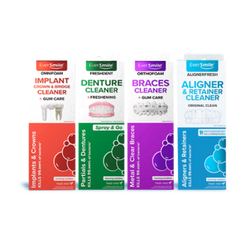
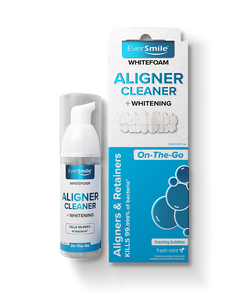
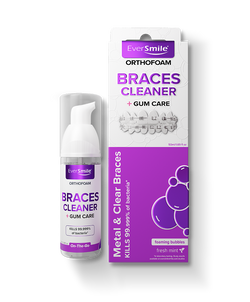
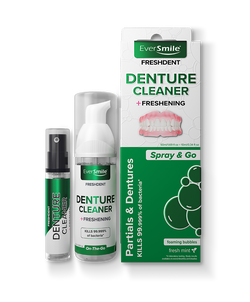

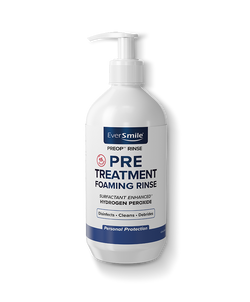





Post a Comment!